Sonic Sessions
Sonic Sessions
Music App Case Study
Preface
This assignment was conceptualized and created for my final project in Music Interaction Design at NYU ITP (taught by Luisa Pereira). As COVID-19 took our classes from an in-person format to one that was remote, I began to think about shared experiences people have with music that oftentimes take place in a remote / more isolated format.
A few months before COVID-19 shifted everything in our lives, I was learning how to DJ and had a biweekly radio residency at Playground Coffee Shop in Bed-Stuy. One big part of my practice was listening to mixes from other DJs to get a sense of how different artists blend songs, beat match, and curate selections. I also, of course, continued to utilize apps such as Spotify to find new music, save songs that I like, and build a collection there.
With both methods, there are affordances and limitations, ones that I wanted to understand in hopes of conceptualizing an interaction that could be slightly different than the options currently available to us.
I identify as a general visual designer and dreamer with not much experience in UX/UI, so although I’m borrowing some terms and format loosely from those disciplines, that is not the breadth of my experience or where I’m ideologically coming from.
Questions Asked + Goals Determined
After having conversations with many people in my inner circles, one thing became clear, algorithms such as how they operate on Spotify are not designed in a way to make it easy to find new artists / new music but work to contain our taste in a small bubble. Frequently it shows us artists very similar to the ones we already listen to or it repeatedly only shows us artists that we already know.
Additionally, there are many things that influence our access to music and experience around what we hear. Spotify has limitations if you aren’t a paid subscriber. Ads are still a big part of our listening experience on most platforms. Playlist sharing is still an integral part of people’s lives with how we find music, but not a big component of music knowledge sharing apps like Genius or Bandcamp. We listen to mixes on places such as Mixcloud and Soundcloud but there isn’t always a track list because it’s not required and we miss the stories behind the mix. Our interactions with artists in these environments are also still limited. My input feels mostly relegated to that of a consumer.
I began my project by asking these questions:
These questions led me to these goals/guidelines, which I then used to inform my design process:
Research
Current Analysis
Many are using apps and websites such as Bandcamp and Spotify to find music, while Genius stands out as the biggest platform for music knowledge exploration through it’s lyrical analysis framework as well as videos where artists discuss the meaning and/or production elements behind the songs.
Music App Case Study
Preface
This assignment was conceptualized and created for my final project in Music Interaction Design at NYU ITP (taught by Luisa Pereira). As COVID-19 took our classes from an in-person format to one that was remote, I began to think about shared experiences people have with music that oftentimes take place in a remote / more isolated format.
A few months before COVID-19 shifted everything in our lives, I was learning how to DJ and had a biweekly radio residency at Playground Coffee Shop in Bed-Stuy. One big part of my practice was listening to mixes from other DJs to get a sense of how different artists blend songs, beat match, and curate selections. I also, of course, continued to utilize apps such as Spotify to find new music, save songs that I like, and build a collection there.
With both methods, there are affordances and limitations, ones that I wanted to understand in hopes of conceptualizing an interaction that could be slightly different than the options currently available to us.
I identify as a general visual designer and dreamer with not much experience in UX/UI, so although I’m borrowing some terms and format loosely from those disciplines, that is not the breadth of my experience or where I’m ideologically coming from.
Questions Asked + Goals Determined
After having conversations with many people in my inner circles, one thing became clear, algorithms such as how they operate on Spotify are not designed in a way to make it easy to find new artists / new music but work to contain our taste in a small bubble. Frequently it shows us artists very similar to the ones we already listen to or it repeatedly only shows us artists that we already know.
Additionally, there are many things that influence our access to music and experience around what we hear. Spotify has limitations if you aren’t a paid subscriber. Ads are still a big part of our listening experience on most platforms. Playlist sharing is still an integral part of people’s lives with how we find music, but not a big component of music knowledge sharing apps like Genius or Bandcamp. We listen to mixes on places such as Mixcloud and Soundcloud but there isn’t always a track list because it’s not required and we miss the stories behind the mix. Our interactions with artists in these environments are also still limited. My input feels mostly relegated to that of a consumer.
I began my project by asking these questions:
- What is an algorithm and does it necessarily/inherently involve a machine? How does an algorithm differ from curation?
- What expectations do we have with algorithms?
- How might a human-centered curation practice meet or break our algorithmic expectations and what do we discover in those moments of meeting/destroying of expectations?
- What happens if we embrace a process that is slower than the machine?
- How do you prioritize which information should be featured? Does there need to be a hierarchy when it comes to knowledge sharing?
- Is truth important?
These questions led me to these goals/guidelines, which I then used to inform my design process:
- Provide an alternative experience to the machine learning big-tech centric experience by creating a platform that is instead curated by individuals and driven entirely by humans
- Create a platform that embraces storytelling through the acknowledgment that mixes are stories and a form of oral histories
- Combine music literacy through active listening alongside but not limited to the exploration of music theory, music history, activism, collective knowledge, and ethnomusicology
- Embrace slow processes over fast prototyping, quick implementations, and expansive outputs -- for me this means, this app does not need to actually become an app! There are no actual deadlines. The market is irrelevant
- Get rid of ads + paid subscriptions
Research
Current Analysis
Many are using apps and websites such as Bandcamp and Spotify to find music, while Genius stands out as the biggest platform for music knowledge exploration through it’s lyrical analysis framework as well as videos where artists discuss the meaning and/or production elements behind the songs.
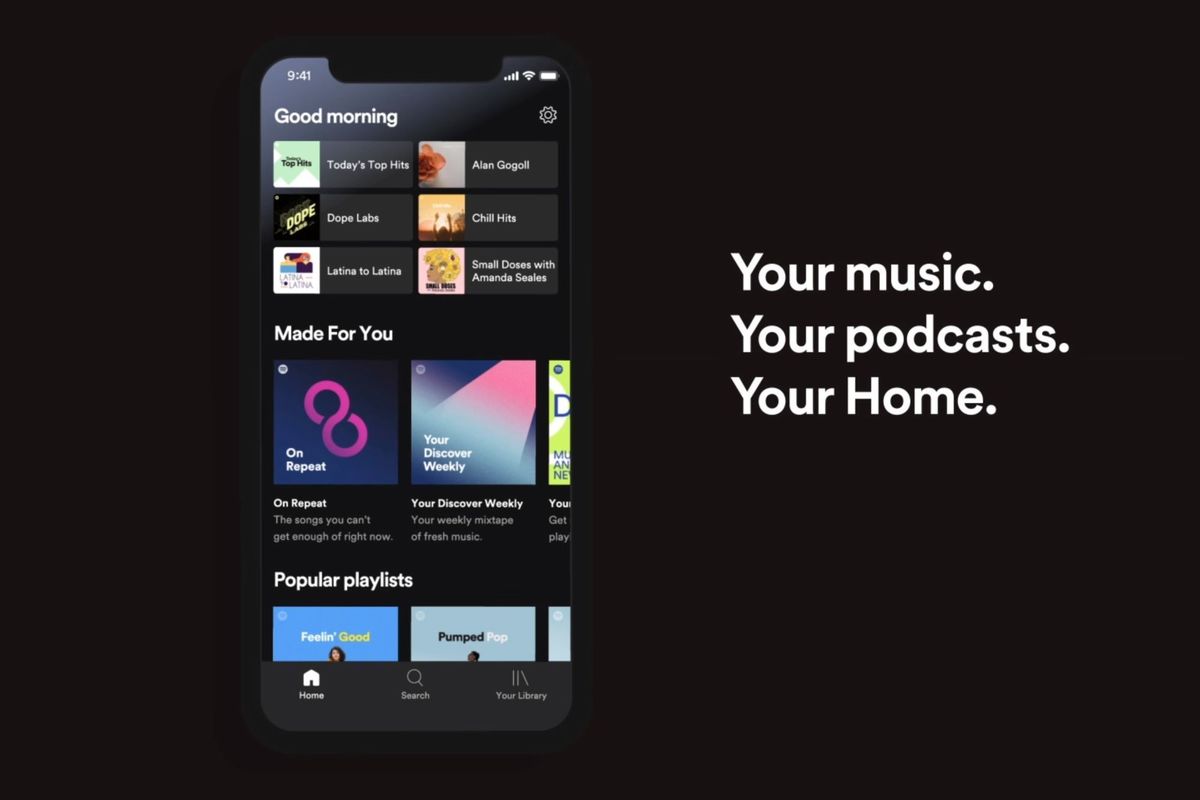
User Research Acknowledgement
Normally, people would do User Research to perform observations and identify how users interact with the app and what user problems and experiences are. I did not perform this kind of research as my intention is not to perfect a problem but rather through design and other research begin to consider alternative realities and experiences that may be possible. Also, I am not interested in actually creating a product and following the traditional format of prototype to product release. I am interested in design simply as a form of communication, as a form of envisioning what could be.
Design Process
Design Principles
I took a Speculative Design approach with this project.
Speculative Design can be described as a critical design practice that uses critical thinking and dialogue to imagine new visions of possible scenarios. It can help us understand and re-think the world by the asking of the question: what if?(More info)
Because of this, my current process does not much occupy itself with user research in the traditional sense and I do recognize that the creation of prototypes may even limit the distance my what-if can travel. I plan to expand upon that in my reflections.
This is also why my inclusion of any form of market research has been light. I am not interested in market analysis to create a competitive product, but I am curious about the market mostly to investigate how we are navigating sonic experiences in our current reality and how these are curated by capitalism.
Ideation
Key functions - What should this platform have?
- Knowledge sharing: DJ profiles + Storytelling during the mix. DJs when submitting their mix will also submit a timecoded track list along with any commentary they’d like to include on screen. When using the app, this commentary will be featured on the screen as people are listening to the mix.
- Communal input: The ability to share knowledge and submit mixes. Those who are on the platform have the ability to submit their own ideas, stories, and knowledge. These would also be shown on the screen. There will be some kind of process to rotate throughout the multiple forms of input on the main screen and also an option to view all that has been submitted. Because input can be received at any point, this creates an opportunity for listeners to continue to learn something new about these curated mixes over time.
- Blog: Extended format storytelling. In addition to the main screen, there will be options to read longer form written entries related to sound and music. This offers the opportunity for people to get involved in multiple ways and increases ability to share ideas in an alternative format.
- Curated Mixes: Not breadth of options + slow. This process is inherently slow and requires that mixes be timecoded, that interested parties submit their mixes to be featured, that we build DJ profiles and create a unique experience for each project. Because these mixes are curated and not designed by algorithms, there won’t be as expansive of a catalogue as Spotify but the hope is to allow for there to be depth and intimacy with whatever is on the platform.
- Unique design profile: Design decided by the artist + in conjunction with the sonic elements in mind. Each mix will have its own unique design profile, color template, background, etc.
Design
Welcome screen + home screen

DJ Profile + Mix Profile

Storytelling + Mix Information
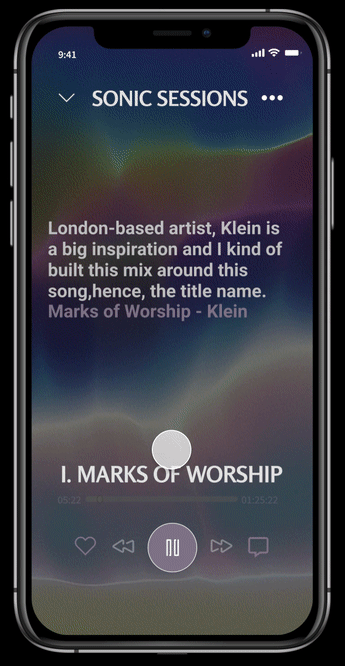
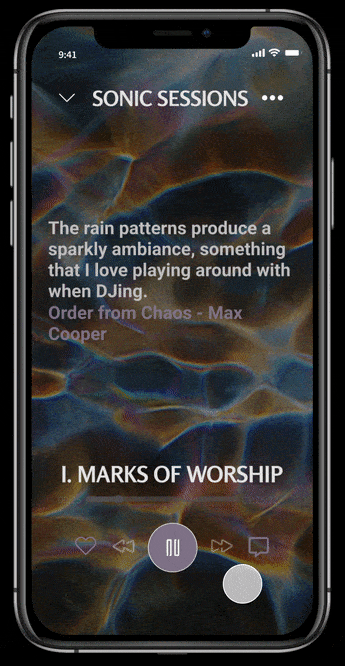
Communal Input Options
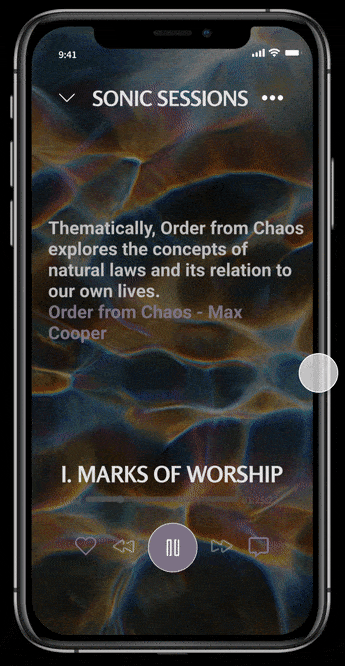
Menu Screen
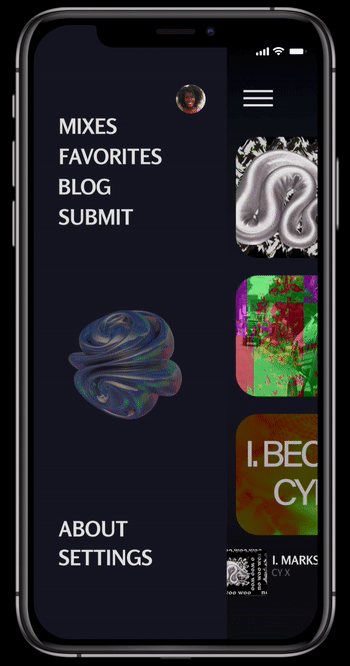
Reflections + Beyond the Constraints of Prototype
Moving throughout the project, I kept hitting against many constraints, mostly mental instead of technical. The project felt at odds with my own interests and ideologies at times. Designing it was exciting in some ways. I am happy with the results, the prototype, but I want to more thoroughly address these convuluted feelings that came up, as well as my initial questions I posed in the beginning of this project.
Upon reflection, I realized that in reality I wanted to embrace speculative design to its fullest and ignore the constraints of capitalism but there were certain expectations in place in my graduate program and maybe even in this class. There’s an expectation to prototype, iterate, and apply these methods such as UX/UI/Interaction Design. These methods oftentimes are used specifically for products, something to be sold, something that can be expanded upon. Embracing these things and forcing a prototype is limiting.
Perhaps, I could have spent more time on the speculative aspects in the beginning, listing every possibility, but would that have been enough for the assignment? What could we create if there was no actual pressure to create? What could we do if there was no pressure that anything actually even needed to work or be able to function with the technology that we currently have?